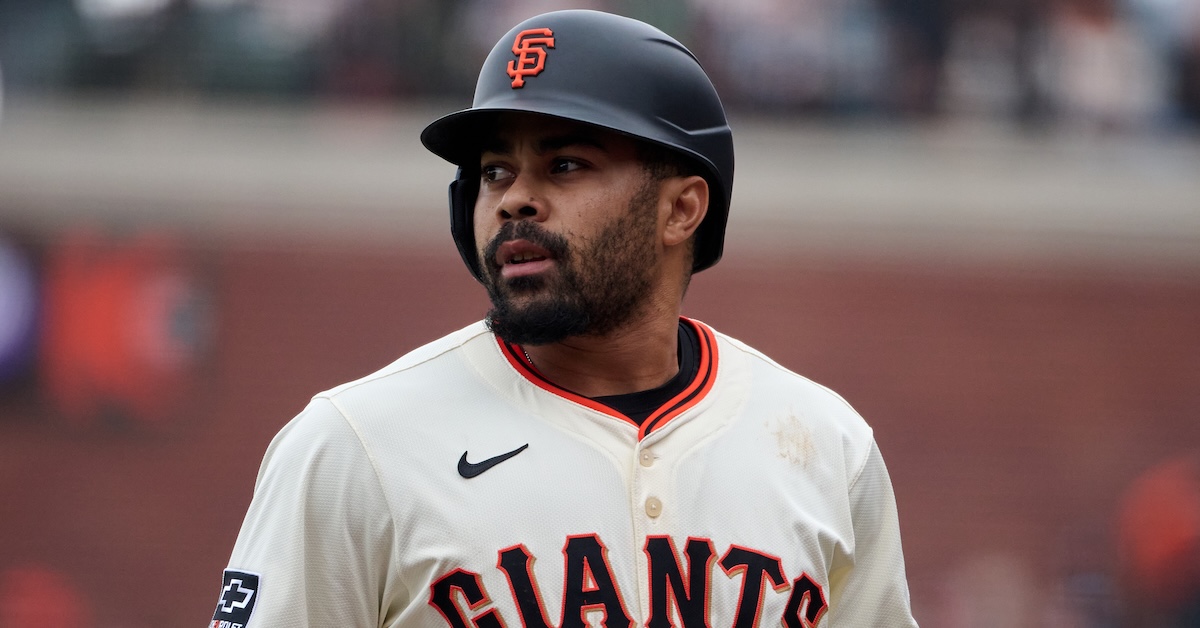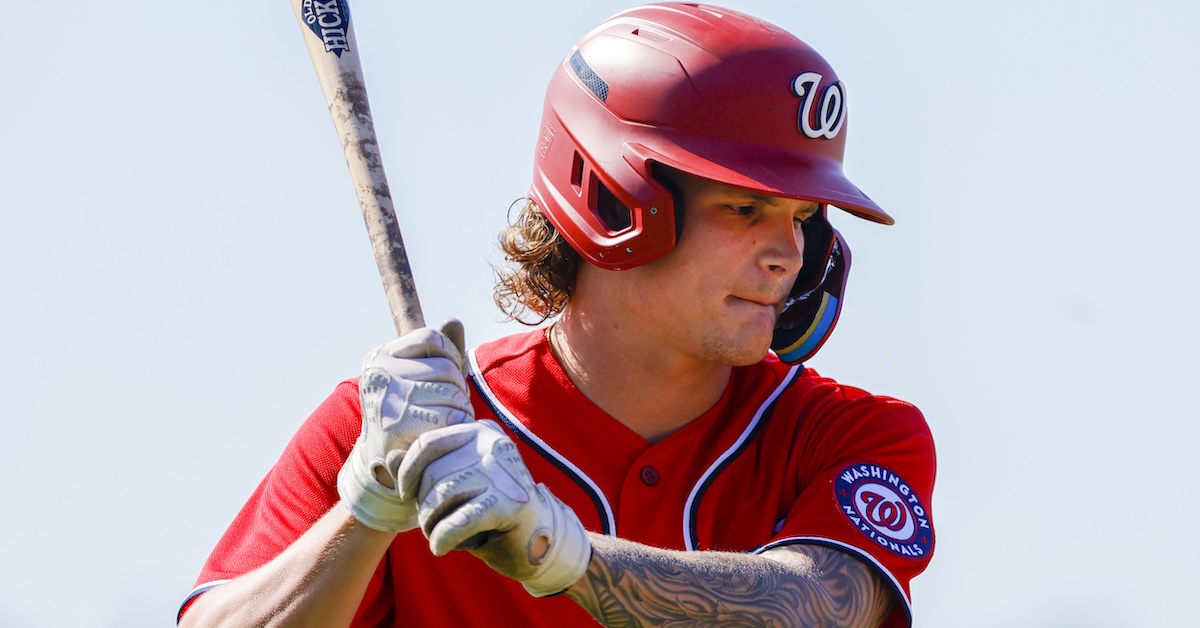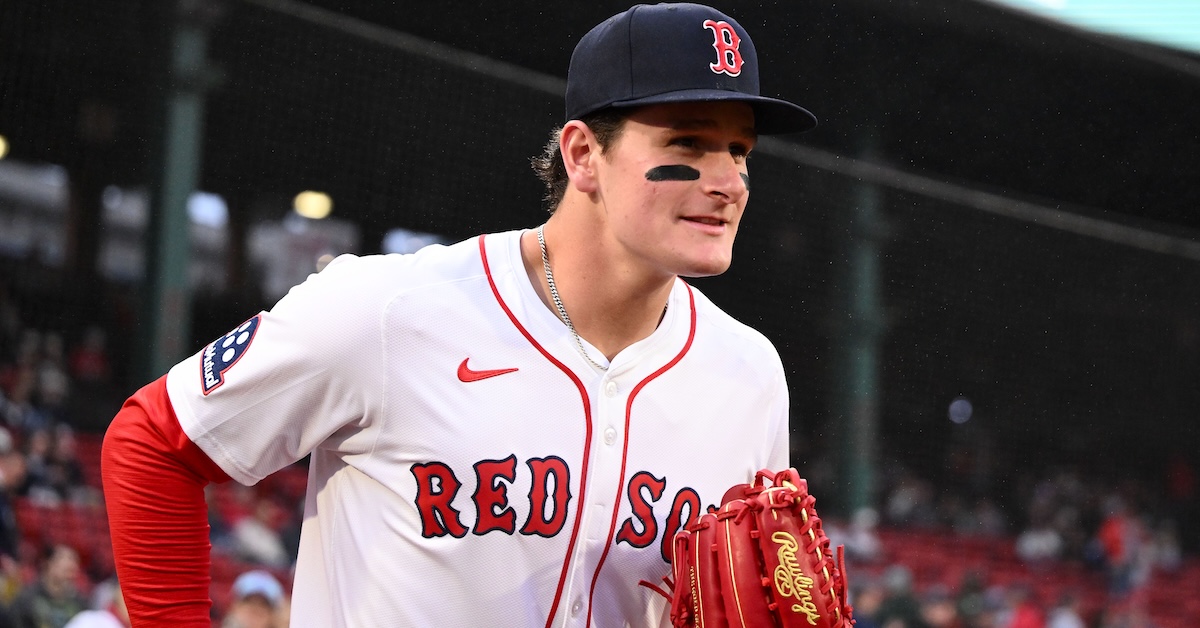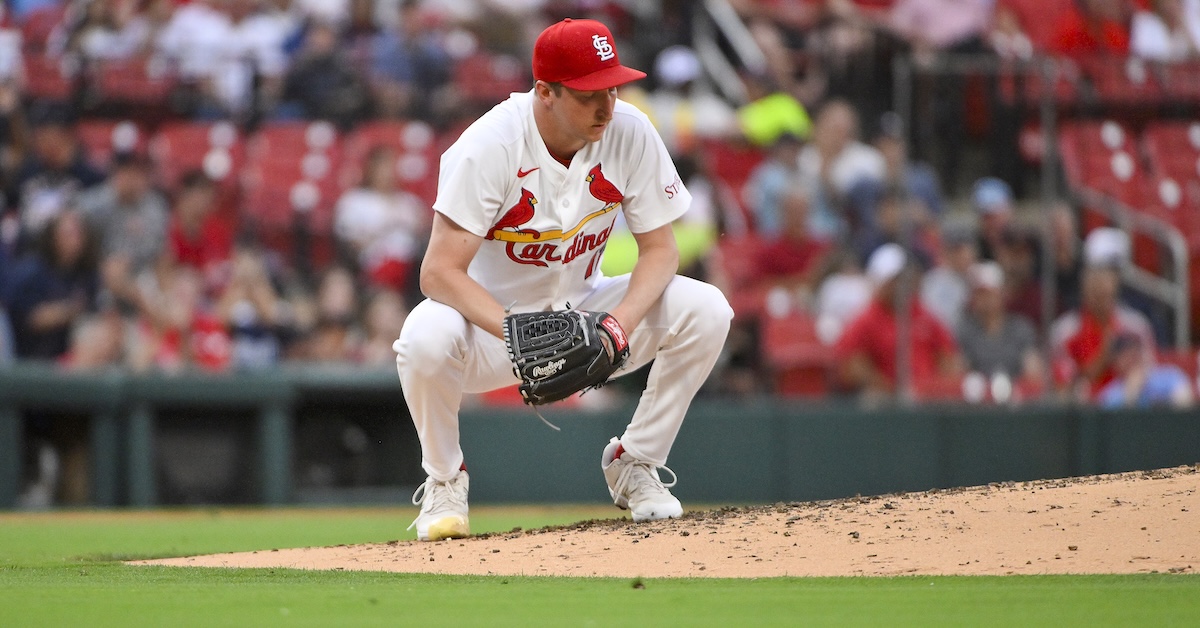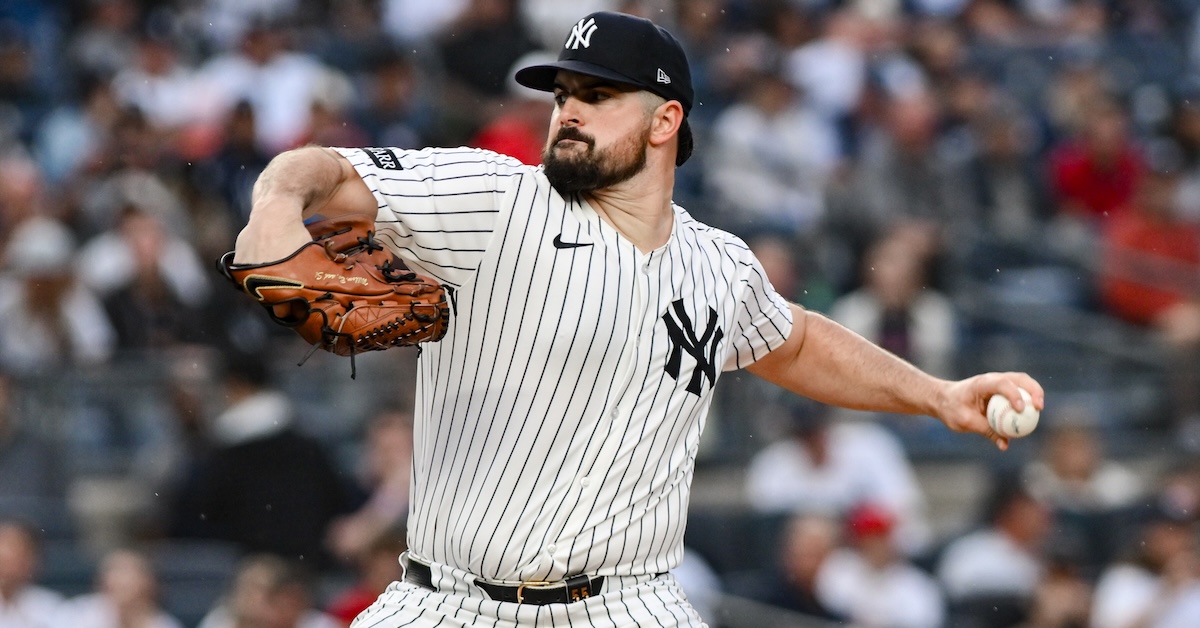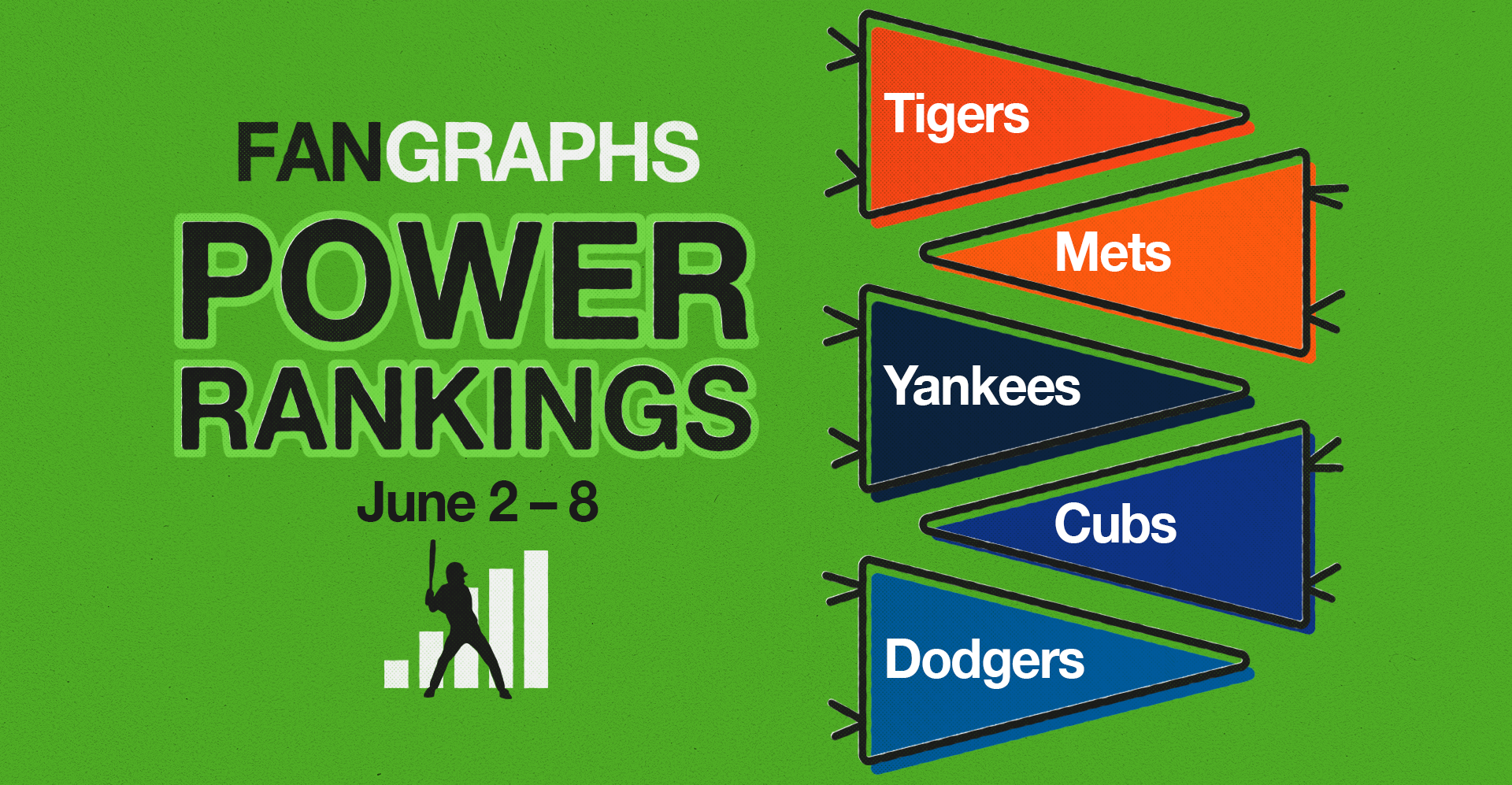
As June gets underway, the American League playoff picture is as muddy as ever — 12 teams are within 4 1/2 games of a playoff berth right now. Meanwhile, in the National League, there’s a pretty clear line between the haves and the have-nots, but even if the playoff picture isn’t as crowded, the races should provide plenty of drama this summer.
Last year, we revamped our power rankings using a modified Elo rating system. If you’re familiar with chess rankings or FiveThirtyEight’s defunct sports section, you’ll know that Elo is an elegant solution that measures teams’ relative strength and is very reactive to recent performance. To avoid overweighting recent results during the season, we weigh each team’s raw Elo rank using our coin flip playoff odds (specifically, we regress the playoff odds by 50% and weigh those against the raw Elo ranking, increasing in weight as the season progresses to a maximum of 25%). The weighted Elo ranks are then displayed as “Power Score” in the tables below. As the best and worst teams sort themselves out throughout the season, they’ll filter to the top and bottom of the rankings, while the exercise will remain reactive to hot streaks or cold snaps.
First up are the full rankings, presented in a sortable table. Below that, I’ve grouped the teams into tiers with comments on a handful of clubs. You’ll notice that the official ordinal rankings don’t always match the tiers — there are times where I take editorial liberties when grouping teams together — but generally, the ordering is consistent. One thing to note: The playoff odds listed in the tables below are our standard Depth Charts odds, not the coin flip odds that are used in the ranking formula.
Complete Power Rankings
| Rank |
Team |
Record |
Elo |
Opponent Elo |
Playoff Odds |
Power Score |
Δ |
| 1 |
Tigers |
43-24 |
1574 |
1489 |
96.2% |
1588 |
0 |
| 2 |
Mets |
42-24 |
1568 |
1480 |
93.0% |
1581 |
3 |
| 3 |
Yankees |
39-25 |
1568 |
1500 |
97.7% |
1577 |
-1 |
| 4 |
Cubs |
40-25 |
1567 |
1507 |
87.1% |
1576 |
0 |
| 5 |
Dodgers |
39-27 |
1568 |
1509 |
98.0% |
1572 |
-2 |
| 6 |
Astros |
36-29 |
1546 |
1500 |
76.4% |
1549 |
2 |
| 7 |
Rays |
35-30 |
1547 |
1505 |
47.1% |
1544 |
6 |
| 8 |
Cardinals |
36-29 |
1544 |
1510 |
43.0% |
1542 |
-1 |
| 9 |
Blue Jays |
35-30 |
1544 |
1510 |
52.7% |
1541 |
3 |
| 10 |
Giants |
38-28 |
1534 |
1499 |
60.4% |
1538 |
6 |
| 11 |
Twins |
35-30 |
1530 |
1487 |
58.6% |
1527 |
-1 |
| 12 |
Padres |
37-27 |
1520 |
1490 |
53.0% |
1526 |
3 |
| 13 |
Phillies |
37-28 |
1520 |
1489 |
76.9% |
1524 |
-7 |
| 14 |
Brewers |
35-31 |
1523 |
1489 |
27.9% |
1516 |
0 |
| 15 |
Guardians |
34-30 |
1515 |
1506 |
40.0% |
1513 |
-4 |
| 16 |
Royals |
34-32 |
1501 |
1492 |
34.0% |
1495 |
1 |
| 17 |
Mariners |
33-31 |
1494 |
1496 |
54.8% |
1491 |
-8 |
| 18 |
Reds |
33-33 |
1497 |
1490 |
7.2% |
1485 |
5 |
| 19 |
Red Sox |
32-35 |
1487 |
1493 |
18.7% |
1473 |
3 |
| 20 |
Diamondbacks |
31-34 |
1485 |
1508 |
25.6% |
1470 |
1 |
| 21 |
Rangers |
31-35 |
1479 |
1506 |
18.0% |
1467 |
-2 |
| 22 |
Angels |
30-34 |
1478 |
1498 |
2.2% |
1466 |
2 |
| 23 |
Nationals |
30-35 |
1479 |
1509 |
1.3% |
1463 |
-3 |
| 24 |
Pirates |
26-40 |
1469 |
1511 |
0.5% |
1448 |
3 |
| 25 |
Braves |
27-37 |
1461 |
1498 |
26.0% |
1442 |
-7 |
| 26 |
Orioles |
26-38 |
1458 |
1492 |
3.0% |
1440 |
-1 |
| 27 |
Athletics |
26-41 |
1417 |
1503 |
0.6% |
1401 |
1 |
| 28 |
Marlins |
24-39 |
1411 |
1509 |
0.0% |
1397 |
-2 |
| 29 |
White Sox |
22-44 |
1398 |
1500 |
0.0% |
1383 |
0 |
| 30 |
Rockies |
12-53 |
1320 |
1528 |
0.0% |
1313 |
0 |
…
Tier 1 – The Best of the Best
| Team |
Record |
Elo |
Opponent Elo |
Playoff Odds |
Power Score |
| Tigers |
43-24 |
1574 |
1489 |
96.2% |
1588 |
| Mets |
42-24 |
1568 |
1480 |
93.0% |
1581 |
| Yankees |
39-25 |
1568 |
1500 |
97.7% |
1577 |
| Cubs |
40-25 |
1567 |
1507 |
87.1% |
1576 |
The Tigers and Cubs battled through a competitive and entertaining series last weekend, with Detroit taking two of the three games. It’s far too early to call this a World Series preview, but it’s certainly a possibility with the way these two teams are playing. The Tigers went 4-3 in their week of games against the two Chicago clubs, and their bullpen blew leads in all three of their losses. For now, this seems like more of a blip than a true concern — the Detroit bullpen ranks sixth in the majors with a 3.30 ERA and a 3.29 WPA, even if the peripherals (3.81 FIP, 3.71 SIERA) aren’t quite as strong — but it’s something to monitor as the season progresses.
The Mets split their NLCS rematch against the Dodgers in Los Angeles last week, with three of the four games being decided by one run, and then went to Colorado and swept the hapless Rockies. Pete Alonso was a one-man wrecking crew; he blasted five home runs and now has 17 on the season. New York has gone 12-3 since falling to three games out of first place with a loss on May 23, and as the Phillies continue to struggle, the Mets begin this week ahead 4 1/2 games in the NL East.
In their first matchup against the Red Sox this season, the Yankees lost two of the three games and allowed 27 runs in the series. Earlier in the week, New York placed closer Luke Weaver on the injured list with a hamstring strain, but the team did get back dynamic infielder Jazz Chisholm Jr.. After missing over a month with an oblique injury, Chisholm went 8-for-21 with two home runs and three stolen bases.
Tier 2 – The Dodgers
| Team |
Record |
Elo |
Opponent Elo |
Playoff Odds |
Power Score |
| Dodgers |
39-27 |
1568 |
1509 |
98.0% |
1572 |
It’s been a rough couple of weeks for the Dodgers. They’re 10-12 over their last 22 games and neither their offense nor their pitching can find much consistency right now. Los Angeles collected 19 total hits in its first two games against the Cardinals last weekend but somehow managed to score just a single run, going 1-for-25 with runners in scoring position. The Dodgers salvaged the series with seven runs on Sunday in a 7-3 win, but their bats are still having a relatively rough go of things since their 18-run outburst against the Yankees the previous Saturday. The concerns about their lineup pale in comparison to the injury woes of their pitching staff, as Tony Gonsolin became the latest pitcher to go down with elbow discomfort. The good news is the Dodgers activated relievers Michael Kopech and Kirby Yates off the IL last weekend and spun an under-the-radar trade for former All-Star closer Alexis Díaz, whom the Reds optioned to Triple-A after a disastrous April. While the Dodgers are letting Díaz work things out in the minors before recalling him, the returns of Kopech and Yates should help to bolster the bullpen; the starting rotation, though, is still spread dangerously thin. Things won’t get any easier for the Dodgers this week, when they face the Padres and Giants for the first time this season. Both teams are just a game behind Los Angeles in the NL West standings.
Tier 3 – On the Cusp of Greatness
| Team |
Record |
Elo |
Opponent Elo |
Playoff Odds |
Power Score |
| Astros |
36-29 |
1546 |
1500 |
76.4% |
1549 |
| Rays |
35-30 |
1547 |
1505 |
47.1% |
1544 |
| Cardinals |
36-29 |
1544 |
1510 |
43.0% |
1542 |
| Blue Jays |
35-30 |
1544 |
1510 |
52.7% |
1541 |
| Giants |
38-28 |
1534 |
1499 |
60.4% |
1538 |
The Astros have gotten hot at exactly the right moment. Their surge has coincided with a Mariners slide; Houston overtook Seattle in the AL West standings in late May and padded the lead last week. The Astros have gone 11-5 over their last 16 games, a stretch that began with taking three of four from Seattle, and are now 2 1/2 games up in the division. Jeremy Peña continues to lead the offense during this hot streak; he collected 10 hits last week and had a 13-game hit streak snapped on Sunday.
The Rays and Blue Jays continued their rise up the standings last week; Tampa Bay swept the Rangers and won two out of three against the Marlins, while Toronto took both of its series against the Phillies and Twins. In 16 games since May 23, Rays third baseman Junior Caminero is slashing .349/.388/.825 with seven home runs and a 242 wRC+. A resurgent George Springer, who smacked a game-winning home run on Saturday, has been the most consistent run producer in the Blue Jays lineup.
The Giants tallied two more walk-off victories last week, bringing their season total to eight. All seven games of their games last week were decided by one run, and they haven’t played a game that was settled by more than three runs since May 23. San Francisco is now 22-11 in home games this season, one of the best home records in baseball. After a 5-2 homestand, the Giants return to the road with a 38-28 overall record, which puts them just a game behind the first-place Dodgers in the NL West.
Tier 4 – Solid Contenders
| Team |
Record |
Elo |
Opponent Elo |
Playoff Odds |
Power Score |
| Twins |
35-30 |
1530 |
1487 |
58.6% |
1527 |
| Padres |
37-27 |
1520 |
1490 |
53.0% |
1526 |
| Phillies |
37-28 |
1520 |
1489 |
76.9% |
1524 |
| Brewers |
35-31 |
1523 |
1489 |
27.9% |
1516 |
The Phillies are phree-phalling right now, with just one win in their last 10 games. That lone win came in their series opener against the Blue Jays last Tuesday, and then over the weekend they were swept by the last-place Pirates. The Philadelphia offense went especially cold, managing to score just one run in four of its last five games. To make matters worse, Bryce Harper was placed on the IL with a wrist injury over the weekend, though it sounds like it might be a minor issue.
Injuries have become an issue for the Twins again, only this time, it’s in their starting rotation. Both Pablo López and Zebby Matthews were placed on the IL last week with shoulder injuries; López is expected to miss at least two months, while it’s unclear as of this writing how long Matthews might be out. Thankfully, Royce Lewis is healthy and snapped an 0-for-28 stretch with a hit on Tuesday, and then notched six more after that.
Tier 5 – High-Variance Hopefuls
| Team |
Record |
Elo |
Opponent Elo |
Playoff Odds |
Power Score |
| Guardians |
34-30 |
1515 |
1506 |
40.0% |
1513 |
| Royals |
34-32 |
1501 |
1492 |
34.0% |
1495 |
| Mariners |
33-31 |
1494 |
1496 |
54.8% |
1491 |
The three teams in this tier all feature flawed lineups with no more than one or two superstars who are tasked with putting the rest of the offense on their backs. The Guardians couldn’t handle the Yankees and Astros last week, though José Ramírez continued to rake. He carries a 34-game on-base streak into Monday’s series opener against the Reds, and he has at least one hit in all but two of those games. Overall, he’s slashing .333/.392/.556 with 12 home runs, 18 stolen bases, and a 163 wRC+. Meanwhile, Bobby Witt Jr. is catching fire after a so-so month of May; though the Royals went just 3-3 last week, Witt brought his season wRC+ up to 126 after going 9-for-25 with two homers. Kansas City also called up top prospect Jac Caglianone last week to bolster what has been one of the worst offenses in baseball. Seattle had a rough week, getting swept by the Orioles and losing two of three against the Angels, but Cal Raleigh bashed three more home runs, extending his major league-leading total to 26.
Tier 6 – No Man’s Land
| Team |
Record |
Elo |
Opponent Elo |
Playoff Odds |
Power Score |
| Reds |
33-33 |
1497 |
1490 |
7.2% |
1485 |
| Red Sox |
32-35 |
1487 |
1493 |
18.7% |
1473 |
| Diamondbacks |
31-34 |
1485 |
1508 |
25.6% |
1470 |
| Rangers |
31-35 |
1479 |
1506 |
18.0% |
1467 |
| Angels |
30-34 |
1478 |
1498 |
2.2% |
1466 |
| Nationals |
30-35 |
1479 |
1509 |
1.3% |
1463 |
| Braves |
27-37 |
1461 |
1498 |
26.0% |
1442 |
| Orioles |
26-38 |
1458 |
1492 |
3.0% |
1440 |
It was the worst-case scenario for Corbin Burnes and the Diamondbacks. First, the ace left his June 1 start with an elbow injury, and then on Friday, Arizona announced he would undergo Tommy John surgery. He’ll miss the rest of the season and most likely all of 2026 as well. It’s a deflating blow to a club that’s been struggling to keep up in the extremely competitive NL West. The rotation has had its fair share of troubles this year, and Burnes’ injury is the biggest one yet.
In a wide open AL playoff picture, it’s not too late for the Rangers to get back into the race, especially if their offense starts to click. To that end, after an abysmal start to the season, Marcus Semien is 15-for-29 with three home runs and a 324 wRC+ over his last nine games. Let’s see if his teammates follow his lead and start mashing this week, when Texas visits Minnesota for three games before returning home to face the White Sox over the weekend.
However, it probably is too late for the Orioles to recover from their disappointing first two months, but at least they’re playing much better baseball recently. They lost their weekend series to the Athletics, but before that, they had gone 9-2 over their previous 11 games. They activated Colton Cowser off the IL last Monday and should be getting Jordan Westburg back from his hamstring injury any day now.
It might be time to admit that it’s just not the Braves’ year. They were swept by the Diamondbacks and the Giants last week, and their seven-game losing streak has dropped them to 14 games back in the NL East and 9.5 games back in the NL Wild Card standings. On Thursday, they blew a six-run against Arizona in the top of the ninth inning, and then lost back-to-back walk-offs against San Francisco on Friday and Saturday. More concerning has to be the ongoing struggles of Spencer Strider; he lost his two starts last week, both his ERA and FIP are up over five, and his Stuff+ is down about 20 points from his last healthy season in 2023.
Tier 7 – Hope Deferred
| Team |
Record |
Elo |
Opponent Elo |
Playoff Odds |
Power Score |
| Pirates |
26-40 |
1469 |
1511 |
0.5% |
1448 |
| Athletics |
26-41 |
1417 |
1503 |
0.6% |
1401 |
| Marlins |
24-39 |
1411 |
1509 |
0.0% |
1397 |
| White Sox |
22-44 |
1398 |
1500 |
0.0% |
1383 |
The Athletics snapped out of a month-long tailspin with a series win over the Orioles last weekend. The A’s peaked on May 5 when they walked off Seattle and pushed their record to 20-16. After that, they lost 24 of their next 27 games before finally beating the Twins 14-3 on Thursday, exactly one month after the high point of their season. During that 3-24 stretch, they allowed 7.8 runs per game, by far the worst mark in the majors.
Tier 8 – The Rock Bottom
| Team |
Record |
Elo |
Opponent Elo |
Playoff Odds |
Power Score |
| Rockies |
12-53 |
1320 |
1528 |
0.0% |
1313 |
Not only did the Rockies finally win a series last week, they secured a three-game sweep of the Marlins! It was their first series win since September of last year and the first time they had won more than two games in a row this season. That winning streak was quickly snapped, when the Mets swept Colorado at home over the weekend. The Rockies are a truly terrible team, no matter how hard Davy Andrews tries to make them look good, but for the sake of all the loyal fans who somehow still show up to their games, hopefully last week’s series won’t be the only one they win in 2025.



